‘Chemtrails’ debunked
How a rare and beautiful atmospheric and aerodynamic phenomenon is fuelling wild conspiracy theories. Aeronautical expert and aviation photographer Dr RON SMITH FRAeS explains how fictional ‘chemtrails’ are being confused with iridescent contrails.
Dip into any social media account that is vaguely related to aviation or aeronautics and one is likely to be accosted by various posts claiming that some undefined agency is using air transport to ‘spray’ the earth’s population with various chemicals. This process is either described as ‘Chemtrails’, or ‘geoengineering’.
In the case of chemtrails, the alleged chemicals typically mentioned include barium, aluminium, human plasma, spreading the COVID-19 infection, or involuntary vaccines, with the supposed intent of anything from weather manipulation, population control, spreading pandemics or psychological influence of the masses.
Contrails or ‘chemtrails’?
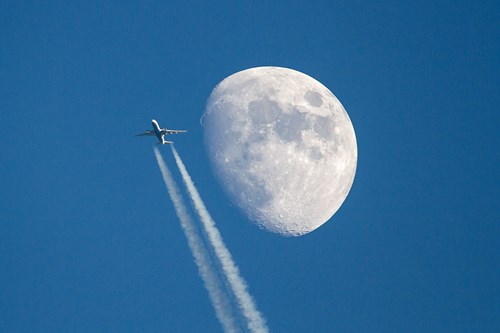
Boeing 777 and the Moon showing conventional engine contrails. (Ron Smith)
Most proponents are aware of airliner engine exhaust contrails, but distinguish these from the long-lasting trails that can be shed in the right atmospheric conditions. These are often described as chemtrails by chemtrail conspiracy believers.
Now, atmospheric scientists will say that the question of whether contrails will occur at all, die out after a short distance, or persist for tens of minutes, or longer, is solely determined by the local atmospheric conditions. The critical issues are humidity and temperature. If the air is very dry, contrails do not form at all, or are of short duration.
In particular, if the air is supersaturated with respect to ice formation, the water vapour in the exhaust contrails turns immediately into ice particles, which can then become persistent and be claimed as evidence of ‘chemtrails’.
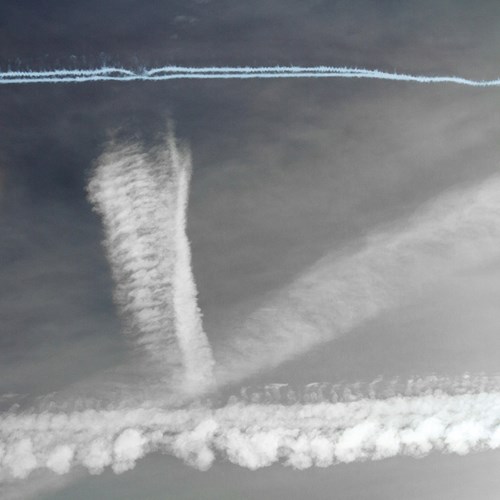
Persistent contrails that might be mistaken as ‘chemtrails’ (Ron Smith)
The formation and duration of contrails is clearly of interest to pilots of reconnaissance aircraft and I well remember (from my schoolboy Air Cadet days visiting RAF Wyton, then equipped with the Victor SR.2), being shown meteorological briefing data emphasising the altitudes at which contrail formation could be expected.
The ‘chemtrail’ conspiracy has to a degree been fed by a few mischievous individuals posting images of cockpit switches labelled as ‘Chemtrail Control’, or images of aircraft under test carrying barrels of water to explore flight conditions at different combinations of weight and centre of gravity.
There are ongoing research activities linked to climate change that suggest that it might be possible to reduce global temperature increases by modifying the atmosphere to reflect more solar energy into space. This is known as solar geoengineering or albedo modification. The fact that this research is known to be underway has added fuel to the conspiracy theorists arguments.
However, as stated by Harvard University: “Study of solar geoengineering is in the very early stages and the topic is (rightly) a very controversial area of climate policy because, if it ever were tested at large scales or implemented, it could involve physical risks and would raise a range of serious socio-political and ethical issues. However, there is nothing secret about the study of albedo modification, with hundreds of publications about the topic in academic journals and … in mainstream media.”
Returning to the real world, there is no indication that the widely proclaimed ‘chemtrails’ are anything more than persistent contrails that occur in well-understood atmospheric conditions. These contrails are claimed to be ‘chemtrails’ because they ‘look different’.
Iridescent contrails
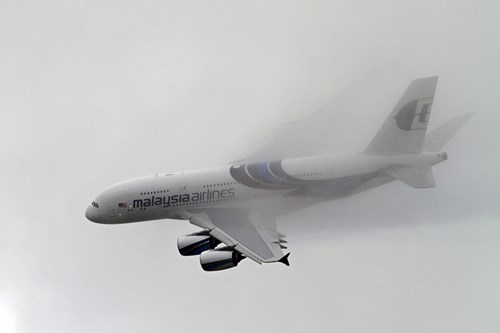
Condensation of an A380 in humid conditions. (Ron Smith)
Now, there is one other type of contrail that does look different; that is the iridescent whole aerodynamic wake contrail. In humid conditions, the reduction of pressure (and temperature) over a wing at high lift conditions can produce condensation over the wing.
If this occurs at altitude in a supersaturated atmosphere, the condensed water particles turn to ice particles, which are left behind the aircraft. This creates a whole aerodynamic wake contrail streaming behind the aircraft. The particles act as ‘seeds’ in the supersaturated atmosphere and grow in size over time. When back-lit by the sun, the particles scatter light with colours that are determined by the particle size. (Fig.4 Boeing 777 showing full aerodynamic wake contrail, July 2015). Not only is this pretty and attractive in terms of flow visualisation, it also enlivens the ‘chemtrails’ debate.
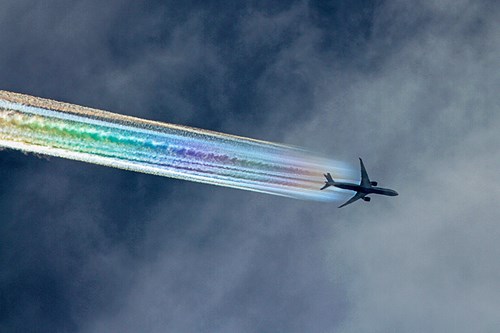
Boeing 777 showing full aerodynamic wake contrail, July 2015. (Ron Smith)
The mechanism described above has been studied by the German DLR (Atmospheric Physics Department) and described in a paper ‘Aerodynamic Formation of Condensation Trails’ by Klaus Gierens, Bernd Kärcher, Hermann Mannstein and Bernhard Mayer. Their paper not only describes the mechanism of contrail formation, but also predicts the downstream particle sizes and the colours scattered in the wake. It also suggests that colours will be visible in the wake for some hundreds of metres behind the aircraft, which is consistent with my own observations.
The 777 image above was my first photograph showing this phenomenon and triggered some thinking about both the process and when to expect to see such contrails. Over the past few years, I have been able to photograph a dozen or more iridescent whole aerodynamic wake contrails, several examples of which are included below.
How to see and photograph iridescent contrails
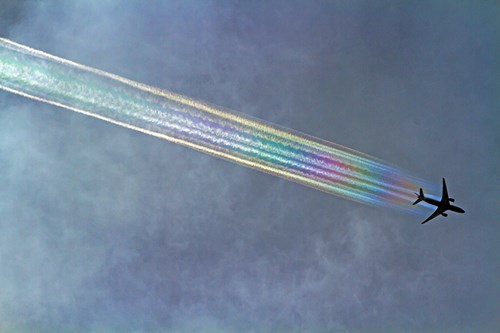
Boeing 777 G-YMMF May 2022. (Ron Smith)
My observations suggest that the following criteria must all be met if such a contrail is to be seen. It goes almost without saying that the weather should be fine and sunny. Contrail conditions in terms of temperature and humidity should exist at (typically) 25 to 30,000 ft. Supersaturation and a temperature near the dew point are also required. There are often small amounts of altocirrus cloud present and these conditions might indicate an approaching warm front.
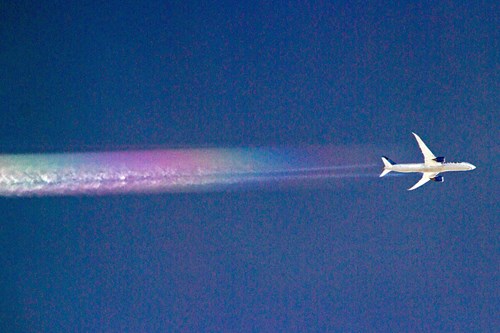
United Boeing 787-9 N25982 March 2023, (Ron Smith)
The aircraft itself needs to be heavy (close to the start of a transatlantic flight, for example) such that the lift coefficient is high enough that a ‘whole aerodynamic wake’ contrail can be produced. From my own location, I have only photographed this phenomenon on westbound transatlantic commercial flights originating from Gatwick or Amsterdam.
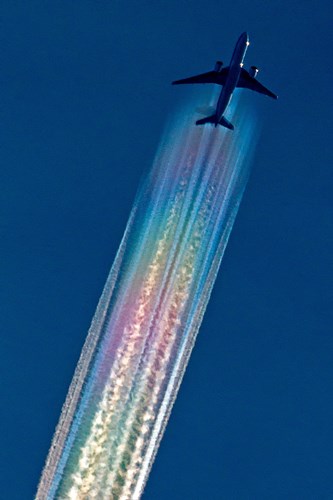
Boeing 777 PH-BQK Sept 2019. (Ron Smith)
Scattering of sunlight is required and ideally the aircraft will be passing (as seen by the observer) within about + / – 10 degrees of sun’s elevation. If present, the iridescent wake will be visible over a significant distance behind aircraft. The colour scattering within the wake gets brighter as the aircraft gets nearer to the line of sight to the sun.
This article has been archived for your research. The original version from Royal Aeronautical Society can be found here.


